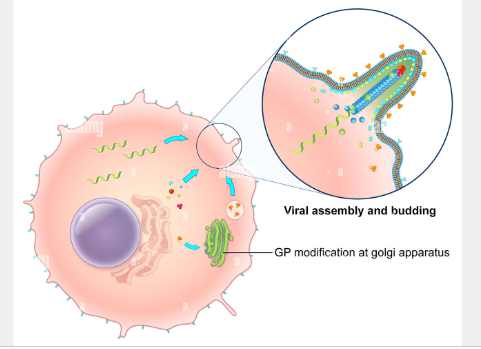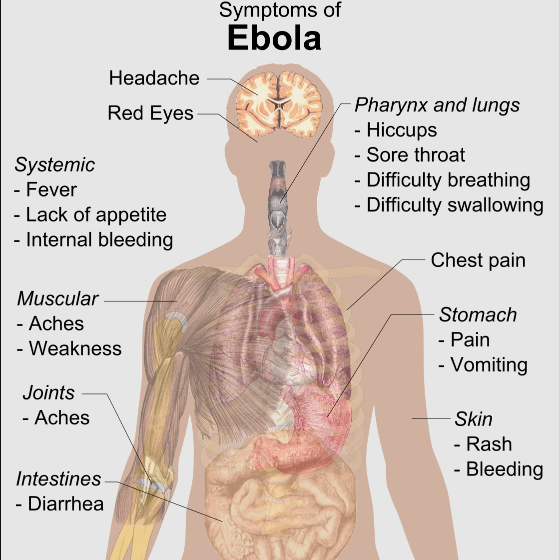Introduction
The Ebola virus disease (EVD) is one of the deadly infections that pose a significant threat to both human and non-human primates. In 2014 the world health organization declared the Ebola virus a Public Health Emergency of International Concern (PHEIC) (Kamorudeen et al., 2020). The declaration called for the international community’s attention in coordinating efforts to reduce the spread of the virus in West Africa. By 2016, more than 11000 deaths had been reported from 28646 cases (Kamorudeen et al., 2020). In the United States, two people who had traveled from West Africa died while two others recovered. Since its discovery, the EVD remains a global threat that requires close monitoring. Although the 2014-2016 Ebola pandemic was contained, in 2018, the virus resurfaced in the Democratic Republic of Congo, killing 2287 people from 3470 cases (Kamorudeen et al., 2020). The virus is highly contagious, making it easier to spread rapidly from one point to another. There is a need for extensive scientific research on the Ebola virus to enable healthcare stakeholders and the public to draft effective measures to fight the infection and prevent future outbreaks.
Rationale
The previous Ebola outbreaks have proved deadly and can easily be uncontrollable within a short time if urgent interventions are not employed. Therefore, this paper aims to provide the necessary information about the virus to help promote public safety and reduce the spread of the disease in case of an outbreak. Providing the public with the essential information about the Ebola virus will facilitate a swift response during an outbreak and significantly reduce the number of victims. Additionally, creating more awareness about Ebola will enable the public to take the necessary precautions against risk factors that can cause an outbreak. The primary objectives of this paper include analyzing the major causes of the Ebola virus, its various modes of transmission, its signs and symptoms, and the various control measures.
Causes of EVD
The Ebola virus majorly affects the blood clotting process leading to internal bleeding. The virus interferes with the blood vessels’ internal lining, causing blood to leak from the vessels into the body, resulting in internal bleeding. Additionally, the Ebola virus tends to cause tissue inflammation and damage. The Ebola Virus Disease can be caused by various viruses, including the Tai Forest virus (TAFV), Bundibugyo virus (BDBV), the Zaire Ebola virus (EBOV), and the Sudan virus (SUDV) (Kamorudeen et al., 2020). The Zaire Ebola virus is considered the deadliest virus and is responsible for causing most of the outbreaks recently. Although the origin of Ebola remains unknown, it is believed to have originated from bats and transmitted to humans and other animals, especially non-human primates, including gorillas and chimpanzees.
The virus causes infections by attaching itself to the cellular membrane of the target cells. The Ebola virus replicates by combining its host cell structures and viral encoded enzymes to produce macromolecular structures that accumulate in the host’s cells (Sridhar, 2022). Once the virus has attached itself to the cell membrane of the target cell, it produces nucleoprotein abundantly, which is responsible for the viral genome replication. The newly replicated genomes accumulate in the cell membrane forming a bud (Sridhar, 2022). When the bud matures, it releases particles that spread to infect other cells by repeating the cycle. Research on the virus’ genetics has been difficult because it is highly virulent.

Transmission
The primary mode of transmission of the Ebola virus among humans is through direct contact with an infected person’s body fluids. Body fluids that carry the virus include blood, saliva, semen, urine, breast milk, vomit, mucus, and feces (Jacob et al., 2020). Most of the transmission occurs through blood, vomit, and feces. Transmission through saliva is not common because only extremely sick people can spread the virus through saliva (Jacob et al., 2020). The virus reportedly can survive in a body fluid outside an infected person’s body for a few days. Additionally, it can survive on dry, contaminated surfaces for a few hours. Having direct contact with contaminated surfaces can transmit the virus. The virus enters the body through various openings, including the nose, open wounds, eyes, and mouth (Jacob et al., 2020). Additionally, the virus can enter the body through abrasions and cuts.
Patients who have recovered from the virus may have it persistent in their semen, thus risking transmission through sexual intercourse. It is believed that the virus can stay persistent in the semen of a recovered patient for more than three months (Den Boon et al., 2019). Furthermore, the virus can reportedly survive in the breast milk of recovered patients for an unknown period (Den Boon et al., 2019). However, people who have recovered from the virus are considered not infectious. Dead bodies are highly infectious, making burial rituals risky events that can lead to transmissions. The burial of victims of the virus must be conducted by people with protective gear with utmost caution to prevent having direct contact with the infected body. Furthermore, healthcare workers are often at a greater risk of infection, especially when they operate without protective clothing or incorrectly handle the contaminated clothing.
Signs and Symptoms
The incubation period for Ebola is between 6 and 21 days. In other instances, the virus incubation period is between 4 and 10 days after infection. There are rare cases where symptoms are more than 21 days after infection (Feldmann et al., 2020). Initial symptoms of the virus include headache, muscle and joint pain, fatigue, sore throat, and fever. Most of the initial symptoms tend to match the influenza characteristics. As the virus develops, the patient starts to experience vomiting, abdominal pains, nausea, and diarrhea. Severe diarrhea and vomiting tend to cause serious dehydration due to excessive body water loss (Feldmann et al., 2020). Additionally, the patient may experience shortness of breath, severe chest pains, and headaches.
After five to seven days after the onset of the first symptom, some patients may experience internal and external bleeding. Bleeding is usually caused by the reduced blood ability to clot. Internal bleeding is often traced in the patient’s stool, vomiting, and coughing blood (Feldmann et al., 2020). Furthermore, bleeding may occur around the injection sites, eyes, and other openings. Some patients may experience heavy bleeding in the digestive tract. Recovering from the infection may begin on the seventh to 14th day from the first symptom. However, death can occur six to sixteen days after incubation (Feldmann et al., 2020). Many deaths are a result of excessive loss of body fluids.

Prevention and Control Measure
Prevention of an Ebola outbreak is a collaborative initiative involving the public and healthcare officials. One of the most effective preventive mechanisms for the Ebola virus is the administration of vaccines (Soeters et al., 2018). There is an urgent need to educate the general population on the risk factors that cause EVD and the mechanisms that can be employed to prevent the spread of the virus. Some protective measures that prevent the spread of the virus include washing hands with soap and running water regularly and maintaining a significant distance from the infected persons. Additionally, disinfecting surfaces using alcohol-based products is essential to eliminate the virus (Soeters et al., 2018). Bush meat should be adequately cooked before consumption.
Conclusion
In conclusion, Ebola is a deadly virus that requires urgent mechanisms to prevent future outbreaks. The virus is highly contagious, making it a significant threat to public health. Effectively managing this virus requires a collaborative approach between the public and healthcare stakeholders. There is a need for extensive public awareness on the preventive practices that can be initiated to avoid the virus’s spreading risk factors. Furthermore, there is a need for broad research to understand the nature of the virus and develop more preventive measures to reduce future outbreaks.
References
Den Boon, S., Marston, B. J., Nyenswah, T. G., Jambai, A., Barry, M., Keita, S.,. & Dye, C. (2019). Ebola virus infection associated with transmission from survivors. Emerging Infectious Diseases, 25(2), 240. 10.3201/eid2502.181011
Feldmann, H., Sprecher, A., & Geisbert, T. W. (2020). Ebola.New England Journal of Medicine, 382(19), 1832-1842.
Jacob, S. T., Crozier, I., Fischer, W. A., Hewlett, A., Kraft, C. S., Vega, M. A. D. L., & Kuhn, J. H. (2020). Ebola virus disease. Nature reviews Disease primers, 6(1), 1-31.
Kamorudeen, R. T., Adedokun, K. A., & Olarinmoye, A. O. (2020). Ebola outbreak in West Africa, 2014–2016: Epidemic timeline, differential diagnoses, determining factors, and lessons for future response. Journal of infection and public health, 13(7), 956-962.
Soeters, H. M., Koivogui, L., de Beer, L., Johnson, C. Y., Diaby, D., Ouedraogo, A., & Diallo, A. O. (2018). Infection prevention and control training and capacity building during the Ebola epidemic in Guinea.PLoS One, 13(2), e0193291.
Sridhar, S. B. (2022). Ebola: Causes, Symptoms and Treatment. Sign.